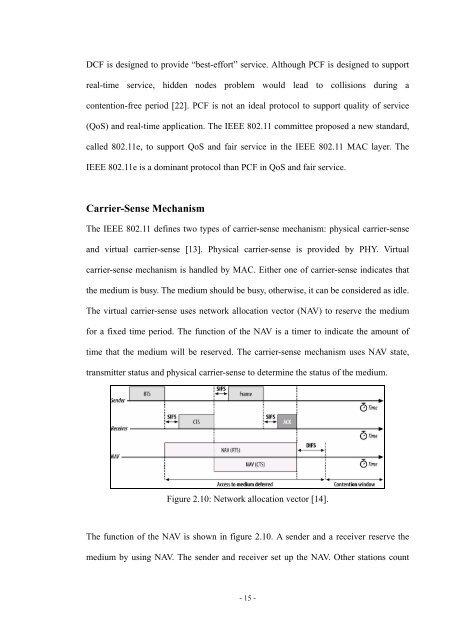An Investigation of the Impact of Signal Strength on Wi-Fi Link ...
An Investigation of the Impact of Signal Strength on Wi-Fi Link ...
An Investigation of the Impact of Signal Strength on Wi-Fi Link ...
Create successful ePaper yourself
Turn your PDF publications into a flip-book with our unique Google optimized e-Paper software.
DCF is designed to provide “best-effort” service. Although PCF is designed to support<br />
real-time service, hidden nodes problem would lead to collisi<strong>on</strong>s during a<br />
c<strong>on</strong>tenti<strong>on</strong>-free period [22]. PCF is not an ideal protocol to support quality <str<strong>on</strong>g>of</str<strong>on</strong>g> service<br />
(QoS) and real-time applicati<strong>on</strong>. The IEEE 802.11 committee proposed a new standard,<br />
called 802.11e, to support QoS and fair service in <str<strong>on</strong>g>the</str<strong>on</strong>g> IEEE 802.11 MAC layer. The<br />
IEEE 802.11e is a dominant protocol than PCF in QoS and fair service.<br />
Carrier-Sense Mechanism<br />
The IEEE 802.11 defines two types <str<strong>on</strong>g>of</str<strong>on</strong>g> carrier-sense mechanism: physical carrier-sense<br />
and virtual carrier-sense [13]. Physical carrier-sense is provided by PHY. Virtual<br />
carrier-sense mechanism is handled by MAC. Ei<str<strong>on</strong>g>the</str<strong>on</strong>g>r <strong>on</strong>e <str<strong>on</strong>g>of</str<strong>on</strong>g> carrier-sense indicates that<br />
<str<strong>on</strong>g>the</str<strong>on</strong>g> medium is busy. The medium should be busy, o<str<strong>on</strong>g>the</str<strong>on</strong>g>rwise, it can be c<strong>on</strong>sidered as idle.<br />
The virtual carrier-sense uses network allocati<strong>on</strong> vector (NAV) to reserve <str<strong>on</strong>g>the</str<strong>on</strong>g> medium<br />
for a fixed time period. The functi<strong>on</strong> <str<strong>on</strong>g>of</str<strong>on</strong>g> <str<strong>on</strong>g>the</str<strong>on</strong>g> NAV is a timer to indicate <str<strong>on</strong>g>the</str<strong>on</strong>g> amount <str<strong>on</strong>g>of</str<strong>on</strong>g><br />
time that <str<strong>on</strong>g>the</str<strong>on</strong>g> medium will be reserved. The carrier-sense mechanism uses NAV state,<br />
transmitter status and physical carrier-sense to determine <str<strong>on</strong>g>the</str<strong>on</strong>g> status <str<strong>on</strong>g>of</str<strong>on</strong>g> <str<strong>on</strong>g>the</str<strong>on</strong>g> medium.<br />
<strong>Fi</strong>gure 2.10: Network allocati<strong>on</strong> vector [14].<br />
The functi<strong>on</strong> <str<strong>on</strong>g>of</str<strong>on</strong>g> <str<strong>on</strong>g>the</str<strong>on</strong>g> NAV is shown in figure 2.10. A sender and a receiver reserve <str<strong>on</strong>g>the</str<strong>on</strong>g><br />
medium by using NAV. The sender and receiver set up <str<strong>on</strong>g>the</str<strong>on</strong>g> NAV. O<str<strong>on</strong>g>the</str<strong>on</strong>g>r stati<strong>on</strong>s count<br />
- 15 -
















